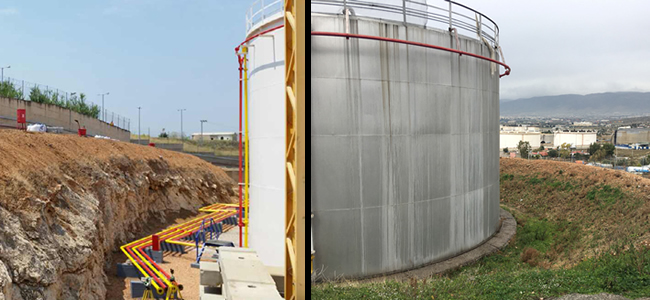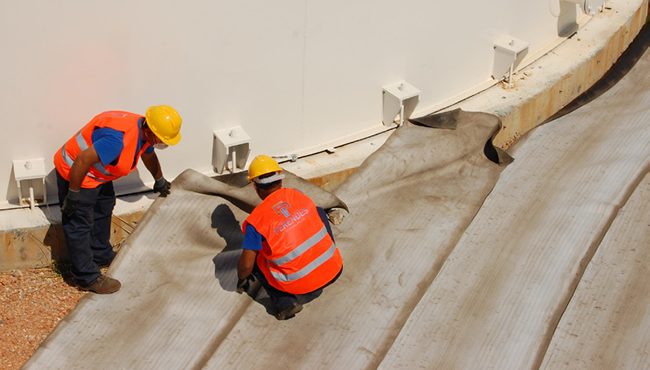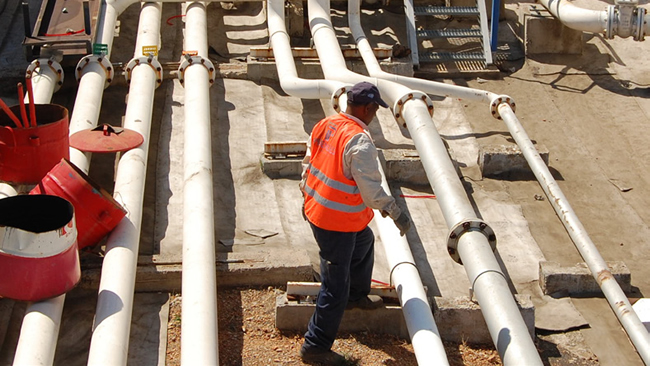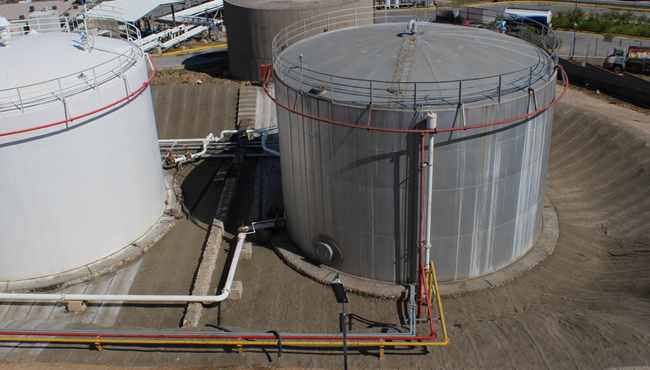Geosynthetic Cementitious Composite Mat (GCCM) materials have grown quickly in adoption around the world in a large variety of containment applications. Bund lining has been one of the most common applications to take advantage of GCCM characteristics and performance.
An exemplary case is the use of Concrete Canvas® GCCM (CC) for bund lining at a petroleum tank farm in Athens, Greece. The existing bunds of the petroleum tank farm were subject to weathering and erosion along one edge of the facility. In other areas, the spread of vegetation created a fire hazard for the warmest periods of the year. The Athens summer can see highs of 48° C (118° F). To resolve the issue, the site needed a new bund lining approach—but it had to be one that could be easily installed without interfering with the existing complex pipe infrastructure.

BUND LINING WITH GCCM
Traditional concrete combined with shotcrete was considered; however, there was a risk of rebound from shotcrete affecting the infrastructure and site environment. The GCCM rolls, however, could be installed safely and cleanly. Site access was also a concern. Traditional concrete would have required the use of a heavy plant on site, which was not have been possible. CC could be delivered in easy rolls.
RELATED: Lining a South African Mine’s Gravity Thickener Tank Floor
With the geosynthetic-concrete bund lining system specified, the works could begin. Perendes Technologies-Anelixis Constructions oversaw the installation for Elin Oil Hellenic Petroleum Company SA. Consultation services were provided by PowerServe Ltd Greece.
In preparation for the installation, all vegetation, rocks, and debris were removed. The ground was re-levelled. Bulk rolls of CC5TM were then delivered to site, mounted onto a spreader beam and lifted using a crane to the crest of the bund slope. The CC was then unrolled, guided by two of the installation team, down the length of the slope. Two other crew members then continued the unrolling of the CC along the tank floor with the same continuous layer.


The CC was fixed at the crest to a concrete slab poured for this project using masonry nails. This process was repeated along the length of the slope, with additional layers overlapping by 100mm. Each overlap was sealed using Everbuild Clearfix adhesive sealant and jointed using Hilti collated screws at 50mm intervals down the slope and at 200mm intervals along the tank floor.
The slope’s rocky surface was drilled and 12mm x 170mm anchor bolts were inserted along with 12mm x 250mm J-pegs to secure the material to the slope and the floor surface. For the other end of the material, where it meets the wall, the same method was used. The CC was fixed onto the existing concrete infrastructure using masonry nails.
SITE FLEXIBILITY
Infrastructure such as the petroleum storage tanks and pipework were easily accommodated due to the drape characteristics and flexibility of CC. The CC was cut using hand tools to shape it around the walls of the storage tanks, corners, and other complex shapes from protruding infrastructure. Where needed, an extra layer of CC was fitted around the item, then sealed. Once the installation was complete, the CC was hydrated using hoses attached to fire pipes. This was repeated three times due to the high temperatures on site (~45° C [113° F]) on site, to ensure adequate hydration.
In total, 6,400m2 of CC5TM were installed in 9 days by a team of 8 workers and two supervisors.
The project team reports that the client was impressed with the simple and rapid installation of CC as well as its immediate effectiveness after laying. The client and contractor also commented on the cost efficiency of CC, the ability to install the material with minimum and basic equipment, and the cleanliness of install compared to other approaches used at similar sites.
Another advantage of this geosynthetic solution in bund lining is the significant reduction of future maintenance. The client is now looking at the suitability of replicating this engineering approach in future bund lining application around Greece.


Learn more about this and other GCCM applications at www.concretecanvas.com.
RELATED: Remediating a Concrete Flume in a Hydroelectric System











